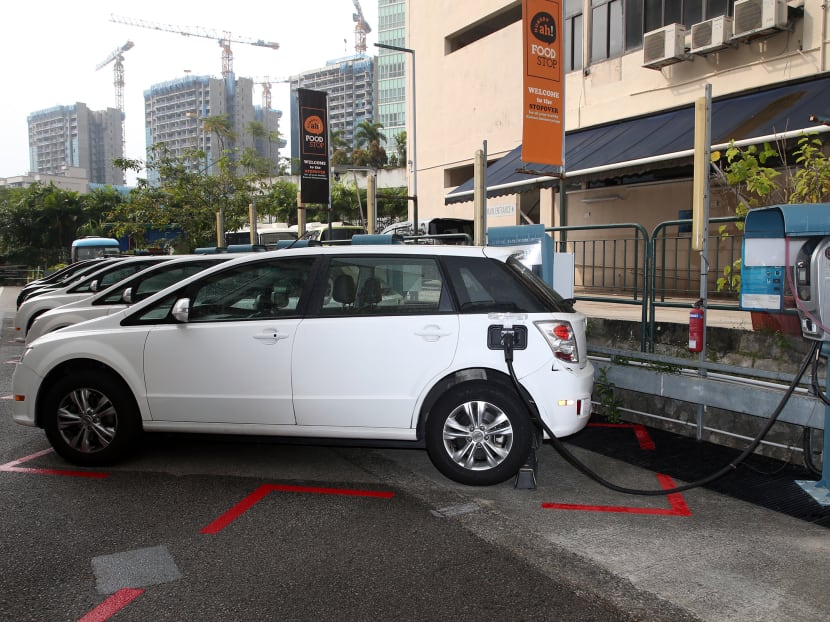S’pore’s electricity grid to be expanded, upgraded to cater for more electric vehicles: Tan See Leng
SINGAPORE — Singapore’s electricity grid will be expanded and upgraded as the Government encourages greater adoption of electric vehicles (EVs), Dr Tan See Leng said on Thursday (March 4).

Second Minister for Trade and Industry Tan See Leng said work to expand Singapore's electricity grid would be spaced out as the country still has a number of years before such upgraded equipment is needed.
- NCMP Leong Mun Wai asked if the power grid can cope with changes to electricity use patterns as more people buy electric cars
- Transport Minister Ong Ye Kung said that even if all cars were electric, only one or two more power-generating units would be needed
- This is equivalent to 8 to 16 per cent of power being generated now
- Second Minister for Trade and Industry Tan See Leng said the Government would space out the expansion and upgrading of the grid
SINGAPORE — Singapore’s electricity grid will be expanded and upgraded as the Government encourages greater adoption of electric vehicles (EVs), Dr Tan See Leng said on Thursday (March 4).
The Second Minister for Trade and Industry said in Parliament: “It is, indeed, a function of supply and demand. What we are doing… is to expand and upgrade the grid.”
Works would be spaced out as Singapore still has a number of years before such upgraded equipment is needed.
Dr Tan was responding to a question from Mr Leong Mun Wai, a Non-Constituency Member of Parliament from the Progress Singapore Party, during a debate on the budget of the Ministry of Sustainability and the Environment.
Mr Leong related a resident’s fear that EV drivers charging their cars at night might lead to a surge in electricity use and, therefore, power blackouts.
He wondered if the electricity grid would be able to cope with changes to electricity use patterns as more people buy EVs.
Also stepping forward to respond to Mr Leong was Transport Minister Ong Ye Kung, who said that a study had been done to understand the impact on the electricity grid, should the entire vehicle population run on electricity by 2040.
In such a case, the increase in generation demand is estimated to be about 600 megawatts-peak to 1,200 megawatts-peak, which can be produced by one or two generating units.
This is the equivalent of 8 to 16 per cent of the power presently being generated, Mr Ong said.
The situation, he noted, would be manageable if EV drivers do not insist on fast charging, but let their cars charge slowly overnight.
“If people start to charge their vehicles at night, when we are all asleep, it's actually quite welcome,” he said.
He said that electricity use is generally lower at night, unlike in the day when there is a lot of economic activity, and charging vehicles at night would smoothen out generation capacity.
Mr Ong added: “If we can live with slow and overnight charging, it is not a huge investment.”
The Republic aims to roll out 60,000 charging points for electric vehicles islandwide by 2030, with an eye to phasing out all petrol and diesel cars by 2040.
Mr Ong said in an earlier parliamentary speech that the authorities would focus on building slow chargers, because fast chargers require a major upgrade of almost all power substations and grid infrastructure.
Mr Dennis Tan, the Workers’ Party’s Member of Parliament for Hougang, wanted an update on the Government’s study on whether battery swapping could complement EV charging. Battery swapping is the exchange of spent batteries for fully charged ones.
Mr Ong said the Government would not rule out any form of technology, but it has become quite clear from the experiences of the United States, Europe and China that EV charging has taken off.
He added that batteries for Tesla cars, among the fastest-selling EVs in the world, cannot be swapped as they sit within the chassis, or the base frame, of the cars.
Mr Ong gave the assurance that boosting EV charging infrastructure here was a “no-regrets move”, based on current trends, technological advancements and the prospect of price parity in a few years between charging-based EVs and combustion vehicles.
Furthermore, the Government is not “going big guns” by building huge infrastructure that runs the risk of being stranded should technology move ahead, he said.
“If we use existing spare capacity, install last-mile chargers, I don't think we are at great risk of any stranded technology risk.”











